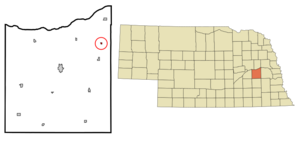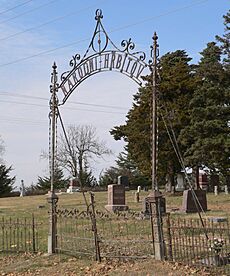Abie, Nebraska facts for kids
Quick facts for kids
Abie, Nebraska
|
|
|---|---|
|
Village
|
|

Downtown Abie (2011)
|
|

Location of Abie, Nebraska
|
|
| Country | United States |
| State | Nebraska |
| County | Butler |
| Township | Linwood |
| Area | |
| • Total | 0.09 sq mi (0.24 km2) |
| • Land | 0.09 sq mi (0.24 km2) |
| • Water | 0.00 sq mi (0.00 km2) |
| Elevation | 1,450 ft (440 m) |
| Population
(2020)
|
|
| • Total | 65 |
| • Density | 698.92/sq mi (270.01/km2) |
| Time zone | UTC-6 (Central (CST)) |
| • Summer (DST) | UTC-5 (CDT) |
| ZIP code |
68001
|
| Area code(s) | 402 |
| FIPS code | 31-00205 |
| GNIS ID | 2397906 |
Abie is a small village in Butler County, Nebraska, in the United States. In 2020, about 65 people lived there. It's a quiet place with a rich history, especially linked to Czech immigrants.
Contents
History of Abie
The first people to settle in the Abie area were called "Yankees." After them, German families moved in. Later, Czech immigrants arrived. Many of these Czech families came from Spillville, Iowa, in July 1869.
The village of Abie was officially planned out, or "platted," in 1877. Many older residents still speak Czech today. This shows how important Czech culture is to the village.
How Abie Got Its Name
The first post office in Abie was set up by Charles "Yankee" Stevens. He asked for the post office to be named after his wife, Abigail Stevens. That's how the village got its name, Abie! Charles Stevens was the postmaster from 1878 to 1888.
Later, in 1905, a system called Rural Free Delivery started in Abie. This meant mail was delivered directly to people's homes in the countryside.
Railroad and Growth
In 1887, the first railroad, the Chicago Northwestern, was built near Abie. Because of the railroad, the original village moved about three-quarters of a mile south to its current spot. This new location was closer to the train tracks. The Western Townsite Company planned the new village in July 1887. The old Catholic cemetery is still located where Abie first began.
The railroad brought a lot of growth to Abie. This busy period lasted until 1928. During these "boom years," Abie became a busy business town. It had many shops and services:
- Two general stores
- A meat market
- A hardware store
- Two places to store grain (grain elevators)
- Two lumber yards
- Two blacksmith shops
- A stable for horses (livery stable)
- A delivery service (dray service)
Later, the village also had car repair shops, a trucking company, gas stations, two taverns, a barbershop, and a beauty salon.
Important Buildings and Organizations
Many important buildings were constructed in Abie during its growth:
- The Bank was built in 1904.
- The first school was built in 1877. A bigger school replaced it in 1905. Today, the old school building is a cafe called Abie's Place. It serves Czech meals and baked goods.
- The Abie Milling Company started in 1905. They made popular flours like White Lily and Pride of Nebraska. Their flour was known for being very good quality.
- The city hall was built in 1912.
- The Parish Hall was built in 1923.
- Ted Sokol Hall was built in 1924.
- The Church was built in 1918.
The Ted Sokol organization began around 1921. This group teaches young people gymnastics and traditional Czech dances. Their main building, the Sokol Auditorium, opened in June 1923. It was a community center for many years but closed in 2017.
Even with some fires and floods in the past, Abie still has many of its old buildings. These historic structures were studied in 1980. Although the railroad closed in 1962, some local businesses in Abie are still open today.
Geography
Abie is a small village. According to the United States Census Bureau, it covers a total area of about 0.11 square miles (0.24 square kilometers). All of this area is land.
Demographics
| Historical population | |||
|---|---|---|---|
| Census | Pop. | %± | |
| 1910 | 210 | — | |
| 1920 | 132 | −37.1% | |
| 1930 | 196 | 48.5% | |
| 1940 | 134 | −31.6% | |
| 1950 | 113 | −15.7% | |
| 1960 | 117 | 3.5% | |
| 1970 | 78 | −33.3% | |
| 1980 | 107 | 37.2% | |
| 1990 | 106 | −0.9% | |
| 2000 | 108 | 1.9% | |
| 2010 | 69 | −36.1% | |
| 2020 | 65 | −5.8% | |
| U.S. Decennial Census | |||
In 2010, there were 69 people living in Abie. There were 34 households, and 19 of these were families. Most of the people living in Abie were White.
The average age of people in Abie was about 49 years old. About 16% of residents were under 18. About 22% were 65 years or older. There were slightly more females than males living in the village.
See also
 In Spanish: Abie (Nebraska) para niños
In Spanish: Abie (Nebraska) para niños


